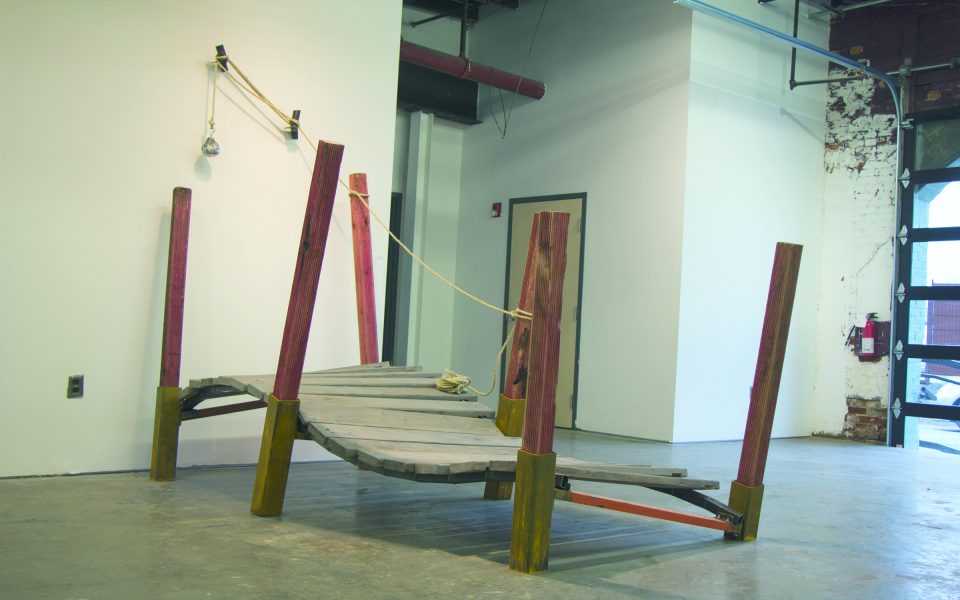Art connoisseurs tend not to expect invitations to waltz atop sculpture installations, but that’s precisely what graduate student and artist Chelsea Tinklenberg enticed several gallery goers to do in the Greensboro Project Space on Dec. 1.
Tinklenberg, 27, is one of eight second-year MFA students at UNCG who traveled to Venice in July. She and her peers drew inspiration from their observations abroad for works that are showcased in their collective exhibit, Catologo Attivo. The Greensboro Project Space is the university’s new contemporary art center, tucked away behind the intersection of Eugene Street and Gate City Boulevard and just around the bend from Gibb’s Hundred Brewing.
Almost all travel in Venice required a ritual ebb and flow of unfastening and refastening the ropes to secure boats to docks. The surreal waterways that serve as Venice’s de facto streets enamored Tinklenberg.
Her life-size rendering of a boating dock juts out 10 feet into the center of the relatively small space, and provides the opposite of stability to those who approach; now it’s the ground that offers constancy and the dock that breeds uncertainty. Eight faded, rhubarb-red poles stand erect in yellow rubber supports, offering a humble framework for the dried-up, ramshackle wooden planks Tinklenberg laid out like a small stretch of a roller coaster. From the side, it’s a playful piece but depending on how quickly and from what angle someone approaches, the whimsy could give way to a desperate search for sea legs.
“I’m playing with this idea of changing perception and engaging with space,” Tinklenberg said, “specifically a type of absurd or unexpected movement that breaks us from our everyday routine.”
In previous work, Tinklenberg experimented with simple and motorized mechanisms like cranks and gears to explore kinetics, but with this piece she urges viewers to physically engage her work and create their own experience with its implied movement.
Their eyes follow an unassuming rope tied three or four times around one of the posts that — rather than attaching to a boat — climbs upward through two steel hooks high on the wall above the dock as a way to reference the variety of hooking connection points Tinklenberg spotted along the canals of Venice. A lone, cast-aluminum cabbage dangles from the end of the rope. The hardy vegetable doesn’t quite belong, but Tinklenberg knows that. She just likes cabbages and typically has several rolling around her home and studio space these days.
“For a long period of history, sculpture had a monolithic form,” Tinklenberg said. “The cabbage is just the cabbage — it doesn’t symbolize anything for me, but it’s important to me to incorporate an unexpected, absurd quality to my work for a contemporary audience.”
This time around, her process reflected that element of impulse. Tinklenberg found more than half of her materials traipsing through Greensboro’s junkyards.
“Greensboro has way more material resources like steel compared to anyplace I’ve been before,” Tinklenberg said. “There’s such a rich history of textile manufacturing here and these amazing old mills. Where I come from [in northern Arizona], we have wood and a Purina factory.”
Since moving to Greensboro, Tinklenberg’s craft has evolved. [pullquote]Learn more about Chelsea Tinklenberg at chelseatinklenberg.com and the Greensboro Project Space at greensboroprojectspace.com.[/pullquote]
“Before, I was very much like, ‘I’m a maker, I’m a craftsperson and I’m going to make everything by hand,’ which is a traditional, romantic notion of what an artist is,” Tinklenberg said.
Now, she sees her role a little differently. Tinklenberg plans to incorporate discarded factory production-line rollers in upcoming work. What potentially disaggregated pieces of the Cone Denim factory, for instance, might local MFA students integrate into their artwork five, 10 or 50 years from now? What will they tell us about ourselves?
That ridiculous cabbage might serve as a little clue: That it’s absurd for any of us to assume that stability is final or that achieving balance is anything rather than an ongoing process. We may as well enjoy our waltz on uncertain ground.
Join the First Amendment Society, a membership that goes directly to funding TCB‘s newsroom.
We believe that reporting can save the world.
The TCB First Amendment Society recognizes the vital role of a free, unfettered press with a bundling of local experiences designed to build community, and unique engagements with our newsroom that will help you understand, and shape, local journalism’s critical role in uplifting the people in our cities.
All revenue goes directly into the newsroom as reporters’ salaries and freelance commissions.


Leave a Reply